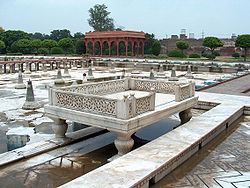Shalimar Gardens, Lahore
31°35′09″N 74°22′55″E / 31.58583°N 74.38194°E
This article needs additional citations for verification. (September 2014) |
| UNESCO World Heritage Site | |
|---|---|
 | |
| Criteria | Cultural: i, ii, iii |
| Reference | 171 |
| Inscription | 1981 (5th Session) |
| Endangered | 2000–2012 |

The Shalimar Gardens (Punjabi, Urdu: شالیمار باغ), sometimes written as Shalamar Gardens, is a Mughal garden complex located in Lahore, Pakistan.[1] Construction began in 1637 AD[2] (1046 AH) and was completed in 1641 AD (1051 AH). The project management was carried out under the superintendence of Khalilullah Khan, a noble of Shah Jahan's court, in cooperation with Ali Mardan Khan and Mulla Alaul Maulk Tuni. The meaning of the word 'Shalimar' remains a mystery, but it is probably of Arabic or Persian origin as asserted by Anna Suvorova in her book 'Lahore: Topophilia of Space and Place'.[3] The Shalimar Gardens are located near Baghbanpura along the Grand Trunk Road some 5 kilometers northeast of the main Lahore city. Shalimar Gardens draws inspiration from Central Asia, Kashmir, Punjab, Persia and the Delhi Sultanate.[4]
History


The site of the Shalimar Gardens originally belonged to the Arain Mian Family Baghbanpura. The family was also given the royal title of 'Mian' by the Mughal Emperor, for its services to the Empire. Mian Muhammad Yusuf, then the head of the Arain Mian family, gave the site of Ishaq Pura to the Emperor shah jahan, after pressure was placed on the family by the royal engineers who wished to build on the site due to its good position and soil. In return, Shah Jahan granted the Arain Mian family governance of the Shalimar Gardens. The Shalimar Gardens remained under the custodianship of this family for more than 350 years.
In 1962, the Shalimar Gardens were nationalised by General Ayub khan because leading Arain Mian family members had opposed his imposition of martial law in Pakistan.
The Mela Chiraghan festival used to take place in the Gardens, until General Ayub khan ordered against it in 1958.
Architecture
The Shalimar Gardens are laid out in the form of an oblong parallelogram, surrounded by a high brick wall, which is famous for its intricate fretwork. This garden was made on the concept of Char Bhagh. The gardens measure 658 meters north to south and 258 meters east to west. In 1981, Shalimar Gardens was included as a UNESCO World Heritage Site along with the Lahore Fort, under the UNESCO Convention concerning the protection of the world's cultural and natural heritage sites in 1972.
Three level terraces of the Gardens
The gardens have been laid out from south to north in three levels of terraces, which are elevated by 4–5 metres (13-15 feet) above one another. The respective names of the three terraces have been listed as follows:

- The upper level or the third terrace named Farah Baksh meaning Bestower of Pleasure
- The middle level or the second terrace named Faiz Baksh meaning Bestower of Goodness
- The lower level terrace named Hayat Baksh meaning Bestower of Life
Fountains
From this basin, and from the canal, rise 410 fountains, which discharge into wide marble pools.It is a credit to the creativity of Mughal engineers that even today scientists are unable to fully comprehend the water systems and thermal engineering from architectural blueprints. The surrounding area is rendered cooler by the flowing of the fountains, which is a particular relief for visitors during Lahore's blistering summers, with temperature sometimes exceeding 120 °F (49 °C). The distribution of the fountains is as follows:
- The upper level terrace has 105 fountains.
- The middle level terrace has 152 fountains.
- The lower level terrace has 153 fountains.
- All combined, the Gardens has 410 fountains.
The Gardens have 5 water cascades including the great marble cascade and Sawan Bhadoon.
Buildings of the Gardens
The buildings of the Gardens include:
|
|
Trees of the Gardens
Some of the varieties of trees that were planted included:
|
|
| |
Gallery
- Shalimar Gardens Gallery
-
East wall corner of the second level terrace
-
Minaret on the west wall corner of the second level terrace
-
A Mughal style structure inside the gardens
See also
- List of UNESCO World Heritage Sites in Pakistan
- Bibi Ka Maqbara also known as mini-Tajmahal, located in Aurangabad
- Mian Family Baghbanpura
- List of parks and gardens in Lahore
- List of parks and gardens in Pakistan
- List of parks and gardens in Karachi
References
- ^ Google maps. "Location of Shalimar Gardens". Google maps. Retrieved 23 September 2013.
{{cite web}}:|last=has generic name (help) - ^ Shalamar Gardens Gardens of the Mughal Empire. Retrieved 20 June 2012
- ^ http://tribune.com.pk/story/327000/the-meaning-of-shalimar/
- ^ http://mughalgardens.org/html/shalamar.html
External links
- UNESCO World Heritage Site Profile
- The Herbert Offen Research Collection of the Phillips Library at the Peabody Essex Museum
- Sattar Sikander, The Shalamar: A Typical Muslim Garden, Islamic Environmental Design Research Centre
- Chapter on Mughal Gardens from Dunbarton Oaks discusses the Shalimar Gardens
- Irrigating the Shalimar Gardens in addition to canal named Shah Nahar Youtube link in Urdu
- Cultural heritage sites in Punjab, Pakistan
- 1642 establishments in Asia
- Fountains in Pakistan
- Islamic architecture
- Landscape design history
- Mughal terraced gardens in Pakistan
- Parks in Lahore
- Persian gardens in Pakistan
- Royal residences in Pakistan
- Visitor attractions in Lahore
- World Heritage Sites in Pakistan
- World Heritage Sites in Danger



